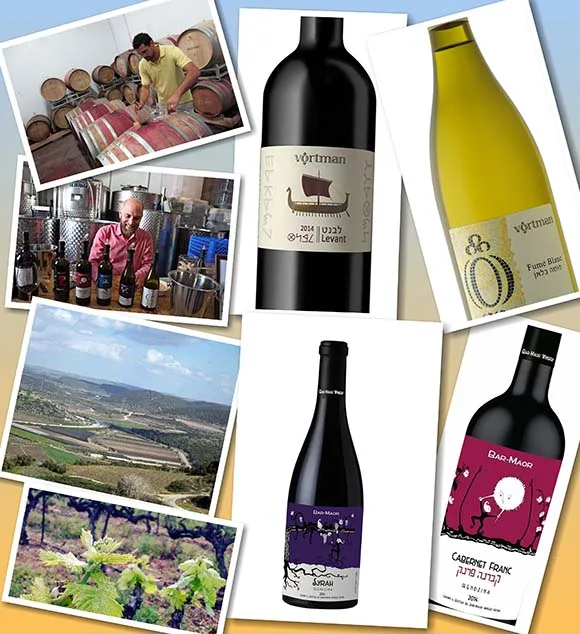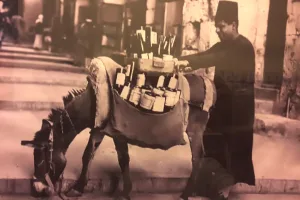When Baron Rothschild founded a modern Israeli wine industry, his agronomists chose the valleys surrounding the southern slopes of Mount Carmel. This is the so called mountain range that runs south from Haifa to Zichron Yaacov. Thus the first vineyards were planted in Shefaya and the Hanadiv Valley, near Zichron, but also in areas such as inyamina, Givat Ada, and Givat Nili.
This region is officially registered in Europe and the USA as the Shomron Wine Region, which is very confusing. Shomron translates to Samaria, and Judea and Samaria represent the central mountains of Israel, otherwise known as the West Bank. So a winery producing Old Vine Carignan from Zichron Yaacov, will according to the archaic Israeli wine law, have to write Shomron on the label as the region. The politically aware wine lover may mistakenly assume the wine is from Samaria.
The reason Shomron was used is because of Biblical geographical history and the topography. The central mountains begin with the Mount Carmel range. However a growing number of people refer to this as the Mount Carmel region that leads south east into the Menashe Hills and south into the Sharon Plain.
Carmel Winery, the main grower of the Shomron Region, has most vineyards in the Mount Carmel region. The family vineyards of Tishbi Winery are also close by. Furthermore, Margalit Winery, one of Israel’s outstanding wineries, has two of his vineyards in the region. Their Cabernet Franc vineyard is in Binyamina and their new vineyard for whites and Rhone varieties is in Zichron Yaacov.
Now in a welcome development, a new regional grouping of wineries has been formed in the area around Zichron Ya’acov. They shy away from names like Mt. Carmel or Shomron, preferring to give focus to where the vineyards are actually situated. So the group is named Bika’at Hanadiv (Hanadiv Valley) and Shefaya. Rami Bar-Maor of Bar-Maor Winery has gathered together wineries that include Somek, Vitkin, Eyal, Smadar, Shefaya, Vortman, Solomonov, Abaya, Arens and Alona. No sign of the large wineries of the region, Carmel, Binyamina or Tishbi. The criteria for qualification is vineyard led. Those wineries with a vineyard in the region that produce a wine from it are able to be part of the group.
The Hanadiv and Shefaya group is a praiseworthy attempt to promote regionality and authenticity of wineries producing wines from the vineyards of the area.
I decided to visit two of the wineries. When I went to visit the little known Vortman Winery, I did not know what to expect. Maybe this was yet another domestic winemaker deciding to cash in on the current fetish of opening wineries. Possibly the scenario would be some enthusiast thrusting a bottle under my nose with the pride of a child showing off a good grade in his homework. I have become quite practiced at not grimacing, and muttering a pareve “interesting”, or some equally meaningless statement, so as not to discourage or show disdain.
Then there was the name Vortman. This conjured up images of a Harry Potter villain. Hai Vortman is an academic looking guy. I suppose the close cropped black curly hair was not very Potter, but the glasses were borderline.
Of course the visit was anything but what I envisaged. It was exciting, inspirational and totally the opposite of my preconceived ideas. I met someone immersed in the magic of wine, who decided that everything done, albeit on a tiny scale, must be with the maximum personal input and investment. A perfectionist, winery owner- winemaker-grower, making handcrafted wines ….with his own hands.
To visit the tiny Vortman Winery, you have no alternative but to visit three different places. First on the list is the vineyard, then the winery and finally the tasting room. The vineyard is in Shefaya the rocky stony valley, north east of Zichron Ya’acov. The soils are sandy clay with pebbles, gravel, a little flint and the white limestone stones so prevalent in this area. These sit on a bedrock of deep, hard limestone. The vineyard experiences a Mediterranean climate, with cooling breezes off the sea, and the valley can trap cold air at nighttime which has a noteworthy cooling effect and brings down average temperatures.
In the vineyard you feel Vortman’s passion. The feeling of joy and abandonment he feels in the vineyard, comes across immediately. This quiet cerebral person, who has a background in computers, is transformed when describing his vineyard. He does not have to explain the release he feels when working there. It is quite apparent. This is someone under no illusion that he grows wine, not grapes.
Then there is the winery situated in downtown Haifa. It is in a miniscule scale but beautifully equipped and spotlessly clean. Here the passion and nature of the vineyard meet the state of the art technology of the winery. It is immediately clear that this is a business that wants to give itself the best possible chance of turning its precious grapes into quality wine.
Finally the tasting and visitors room is in the serene family home in the leafy Shambour district of Haifa, overlooking the most gorgeous view. Here the grower-winemaker, turns into an educator. Sharing his art with someone who is interested is a delight to any artist. Hai’s eyes sparkle as he explains every nuance and consideration in the making of the wine.
You can taste wines with examples of the terroir in a glass bowl in front of you. If you lift your eyes for a moment, you see craggy, stony terraces containing vines and lemon trees, which vie with the more common pines of the forests on Mount Carmel, leading down to the lapping waters of the Mediterranean Sea.
Vortman is a newish kid on the block, but is here to stay. He is a Sauvignon Blanc specialist, using fruit from his 40 year old vineyard. All his whites are particularly good quality and the reds are very drinkable with good balance. Also look out for his Colombard and Carignan, and he has an excellent Petit Verdot.
VORTMAN SAUVIGNON BLANC 2016 Mainly Sauvignon Blanc with a touch of Colombard. Unoaked. The wine has a greenish tint. It is aromatic , blowsy with tropical notes, flavorful with a slight bitterness on the finish which actually makes it more refreshing. PRICE: 70 ILS
VORTMAN FUME BLANC 2015 Made from Sauvignon Blanc aged in barrels. The wine has a complex fresh nose combining tropical with citrus notes, a fruit led flavor and a long refreshing finish. The oak is not overly apparent. PRICE: 95 ILS
VORTMAN SHAMBOUR 2013 blend of Cabernet Sauvignon, Carignan, Merlot and Cabernet Franc. Fruit forward, mouth filling flavor with a good, well defined finish. Represents great value. PRICE: 80 ILS
VORTMAN LEVANT 2014 blend of Merlot, Petite Sirah, Petit Verdot and Cabernet Sauvignon. Medium bodied, nicely weighted wine. Fruit is complex, restrained but not in your face. Black berry fruit is backed by hints of Mediterranean herbs. Nice length on the finish. PRICE: 100 ILS
Bar-Maor Winery may be found not far from Railway Station in Binyamina. Rami Bar-Maor is an ex architect who worked with the famous sculptor Dani Karavan. He is quiet with a dry delivery, sparse on top, with coat hanger shoulders, but when he gets into his wine and talks about his philosophy, the arms gesticulate, the voice is raised and he becomes more animated. He becomes a different character all together. Rather like the newly opened bottle of wine that does not show itself and appears closed. But after being aerated and allowed to breathe, it begins to show its personality. It appears he lives through his wine. Wine does that sometimes!
He makes his wine from the Hanadiv (benefactor) Valley, named after Baran Edmond de Rothschild, who made the southern part of the Mount Carmel region the main focus of his efforts to renew Israeli winemaking after 2,000 years of stagnation. The vineyard soils are Rendzina chalk. Bar-Maor practices a total laisser faire way of winemaking with minimum intervention and making wine as naturally as possible. In the vineyard he does not irrigate artificially. The roots of the vine burrow deeper in search of water and nutrients. At the winery only the free run juice is used, there no corrections to acidity, no filtration or cold stabilization. Bar-Maor’s methodology gives a life and freshness to the wines that have become his trademark.
He caught the winemaking bug and then helped at the iconic Margalit Winery. A light went on in his mind and his passion has not been assuaged yet. His wines have bright, colorful labels which are like the wines. Unique expressions of a particular place, made by an individual. The essence of wine: a combination of the wine, person and place. Bar-Maor’s red wines are recommended but his Riesling is also special, as is the top of the range Archetype, an excellent but rare Mediterranean blend of Marselan, Carignan and Syrah.
BAR-MAOR TAMMUZ 2014 summer wine made mainly from Merlot. Fruity, refreshing with good acidity PRICE: 110 ILS
BAR-MAOR LILITH 2014 Cabernet Sauvignon based blend balanced with a little Syrah. The most conventional of Bar-Maor’s wines. Full bodied with prominent ripe black fruit wromas, quite an oaky backdrop and a long balanced finish. PRICE: 119 ILS
BAR-MAOR CABERNET FRANC 2014 This wine has attractive aromas with a combination of red and black fruits and a touch of green pepper. The flavor is fruitful with a touch of a herbaceous character. The tannins and acidity provide grip and accompany this wine through to the finish. PRICE: 135 ILS
BAR-MAOR SYRAH 2014 This full bodied wine has all the black fruit associated with a Syrah with a smokiness and a touch of leather. The wine has good acidity and well integrated tannins. It is big but refreshing with a long finish. PRICE: 145 ILS
These two wineries are amongst those giving life to the most traditional wine region in Israel, in the valleys surrounding the southern slopes of Mount Carmel. Both Vortman and Bar-Maor make authentic wines representing the terroir of their respective vineyards. If you want to know what bottled passion tastes like, try the wines!
Adam Montefiore has been advancing Israeli wines for over 30 years. He is known as the ‘English voice of Israeli wine’. He writes his regular Wine Talk column for the Jerusalem Post.
www.adammontefiore.com


















